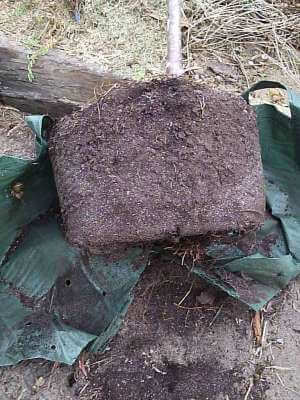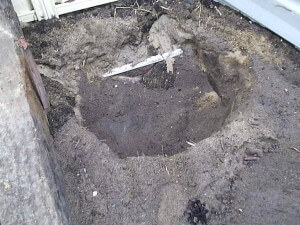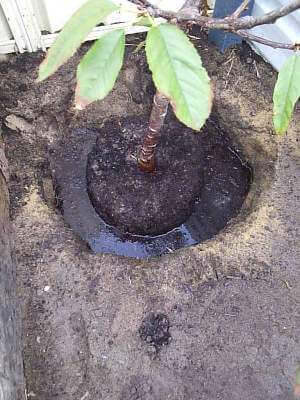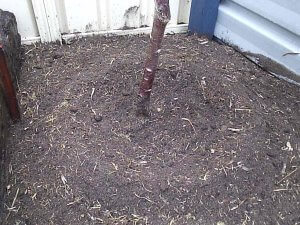Planting a tree isn’t much different to planting a shrub (which is at the bottom of this post) just that everything is a little bigger and more effort is needed. The planting instructions given here will apply for all trees whether they be fruit trees, deciduous or evergreen and even ornamental trees.
More...
Step by Step Guide on How to Plant a Tree
Step 1. Carefully remove the tree from its container
Carefully remove the tree from the bag or container that it has been living in. If the tree has become rootbound (ie. the roots have coiled themselves around the outside of the soil) carefully tease them out from the ball and untangle from themselves.
If the roots have become too matted you can cut away some of the root mass but without disturbing the other roots and still keeping the root ball intact. Don’t try shaking the soil from the roots, instead keep the root ball as compact as possible.

Carefully remove the tree from it’s container
Step 2. Prepare the Planting Location
Prepare a hole in the garden bed where you intend to plant your tree making it twice the width of the tree's root ball dimensions. This will give you some room to play with when positioning the tree.
Apply some quick release organic fertiliser to the soil to encourage root growth and mix in. If you have heavy clay soils you may also want to add a handful of dolomite to aid in the breaking down of the clay and to give your roots an easier start in their new position.

Prepare a hole where you intend to plant your tree
Step 3. Size Up Your Tree
Now that the hole has been dug and the soil prepared it’s time to place your tree in position. I always like to size a tree up before planting it as each tree will have profiles that appear better viewed from certain directions.
This may be due to previous pruning or even the natural growth of the tree. Find the “face” of the tree that you like the most and position it where most people will view it from. Position the tree in the middle of the hole keeping the top of the root ball level with the height of the soil.
If you need to stake the tree then it is best to do it now rather than after you’ve replaced all the soil. Staking it prior to replacing the soil ensures that you won’t accidentally stake the root ball and sever any important roots.
To stake it, drive a strong stake diagonally through the soil opposite the direction you intend to force. Do not drive the stake through the root ball.
Step 4. Watering Your Tree
Half-fill the hole with water adding some water crystals or rotted organic matter to the hole if the soil begins to repel the water. The gradually backfill the soil into the hole carefully tapping the soil and gently shaking the trunk of the tree to remove any air bubbles.

Half-fill the hole with water
Step 5. Create a well around the base of the tree
The final step in planting a tree is to create a well around the base of the tree and water. You can then cover this with sheets of newspaper, a generous dose of sheep manure and finally covering with some pea straw.
This will ensure the tree is fed throughout the season while also suppressing any weeds trying to compete with your new tree.

Create a well around the base of the tree and water
Note: When planting a tree, it's important to consider its root growth to prevent potential issues with tree roots interfering with fences, walls, paths, septic tanks, and sewer pipes. Taking into account the tree species and its root behaviour can help avoid such problems.
When is the best time to plant a tree?
People often ask this question and the answer is anytime is a good time to plant a tree, however there are times that are better than others. Planting a tree in the middle of summer is probably not the best time but if you handle it well and ensure that it gets watered every day for the first week or two you shouldn’t have any problems with it.
Planting trees in the autumn or winter are usually the best times as this is when most trees shut down and require less care and nutrients for survival. However, it depends on what type of tree it is and whether the temperature of the soil will adversely affect the tree you intend to plant.
When is the best time to transplant a tree?
When they’re dormant. This is the end of autumn through to the end of winter. If you try to transplant a tree during the summer months you increase the chances that it may not survive.
How to Plant a Shrub
If you’ve ever had shrubs that didn’t plant well, and perhaps even died, take a look at how to plant them well.Start off with the basics, something to dig with, some water and fertiliser and of course, your new shrub – this is Callistemon viminalis ‘Little John’.
Step 1. Prepare Where You'll Plant the Shrub
Dig the hole twice the width of the pot and to the same depth as the root ball. (Note: I usually would mix 1 part of this soil with 1 part cow manure and 1 part soil improver. In this case though, as it’s an Australian native shrub, they’re not big on fertiliser so I’ll just stick to the blood ‘n bone.
Step 2. Transplanting the Shrub
Transplant the shrub into the hole teasing any roots out if it’s badly rootbound. Half-fill the hole with water and then backfill with the soil. Water generously after the shrub’s been planted and then water regularly, at least every second day for the next couple of weeks.
Step 3. Relax and Enjoy Your Garden
Make yourself a cup of coffee or herbal tea, stand back and admire the potential vista.
Published on June 7, 2023 by Nathan Schwartz
Last Updated on September 18, 2023




